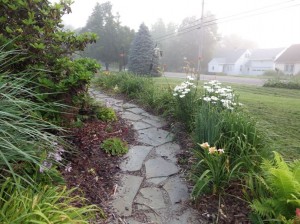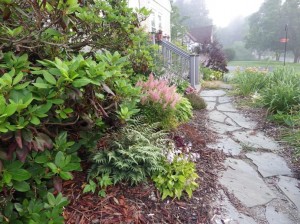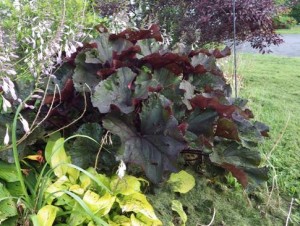 Something everyone who gardens (and even if you are getting someone else to do the ‘sticking their hands in the dirt and planting’ part, you are gardening) should do, once a year, is look at what you’ve got, evaluate what is working, not working, and so on. I went out this morning (and pardon the fog in the photos – very foggy this morning, which is a real function of where I live in general — Upstate NY has plenty of moisture — and in specific — where Chez Siberia is located is a valley so we tend to get serious fog conditions here if there is any moisture in the air at all) to take a look at the walk in front of our house.
Something everyone who gardens (and even if you are getting someone else to do the ‘sticking their hands in the dirt and planting’ part, you are gardening) should do, once a year, is look at what you’ve got, evaluate what is working, not working, and so on. I went out this morning (and pardon the fog in the photos – very foggy this morning, which is a real function of where I live in general — Upstate NY has plenty of moisture — and in specific — where Chez Siberia is located is a valley so we tend to get serious fog conditions here if there is any moisture in the air at all) to take a look at the walk in front of our house.
Now, this is on the east-facing side of the house and in general is pretty well protected from the wind (which tends to come from the north and northwest and down the hill in back of the house). About 7 years ago, we planted a wind-break of willow and forsythia up the hill and this has tempered the wind coming down off the hill somewhat, but when we have a brutal winter such the one we just had, even that will not be enough to save some of the plants.
First to the bad news: As you can see from the brown leaves on the rhododendron on the left, there was lots and lots of frost damage on this shrub. Last year, we had a lot of damage as well and we basically did major surgery on it and it bounced back. We did not make time to do this, this spring and it shows. Next year, the pruners come out. The right hand side is nicely filled out – frankly, I’m sure that the walk-shoveling did the trick because all of that walk on the street-facing side was probably 3-4 feet under snow. Snow is a wonderful protection in the winter and in general, it did a terrific job protecting the plants. Even the ‘Sheffield Pink’ perennial chrysanthemum (which is rated, at the bottom end of its range, at zone 5 – yes, I realize that at Chez Siberia, this is a huge risk, but as a gardener, you have a take a few), which took a horrific beating over the winter, limped into the spring and is sending out shoots and branches. With a bit of protection this winter, I think it will come back.
At least, I hope it will. it is a very nice plant – grows to about 3′ high and 3′ around and is a September/October bloomer, which makes it very welcome in the garden.
 A bit farther in and on the left-hand side. Now, on the one hand, this area does not get a lot of snow mulch because frankly, when I’m shoveling there, I’m moving from the driveway IN and my natural throwing motion is to the right. And, with the bushes there, it’s a lot more difficult to throw to the left in any case. BUT, this is the area which is truly protected by the house and it shows after this winter, when our low temperatures got down to minus 27 degrees F.
A bit farther in and on the left-hand side. Now, on the one hand, this area does not get a lot of snow mulch because frankly, when I’m shoveling there, I’m moving from the driveway IN and my natural throwing motion is to the right. And, with the bushes there, it’s a lot more difficult to throw to the left in any case. BUT, this is the area which is truly protected by the house and it shows after this winter, when our low temperatures got down to minus 27 degrees F.
Even the least-hardy (and I realize that for some readers, this is all relative as your locations are in warmer climates) items there, such as the heather, came back like champs from the winter and the hardier items, such as the hostas and heucheras (which go down to zone 3 and 4 respectively) look terrific. A plant you cannot see (because it’s to the other side of the stairs) is a purple form of leopard plant (Ligularia dentata “Marie Crawford’).  There are a bunch of forms of ligularia (‘ragwort’), but if you are going to give space to a plant in your garden, I always go for ‘knock your eyes out’ glory and this one is IT. Three to four feet tall and taking up about as much room around, this plant looks terrific from the moment it emerges in the spring right through killing frost. The flowers, I’m sorry to say, are rather untidy (as my mom would call it), bright yellow-orange affairs that stick above the foliage, but this is a plant you grow for the foliage and it will grow in anything from full sun to full shade. My only complaint (and this is my fault) is that I planted the yellow-green hostas too close to it and it basically overwhelms them. If I can pull those hostas out about 8 inches further to the front (time to ‘enbiggen’ the bed…AGAIN), they will play together much more nicely.
There are a bunch of forms of ligularia (‘ragwort’), but if you are going to give space to a plant in your garden, I always go for ‘knock your eyes out’ glory and this one is IT. Three to four feet tall and taking up about as much room around, this plant looks terrific from the moment it emerges in the spring right through killing frost. The flowers, I’m sorry to say, are rather untidy (as my mom would call it), bright yellow-orange affairs that stick above the foliage, but this is a plant you grow for the foliage and it will grow in anything from full sun to full shade. My only complaint (and this is my fault) is that I planted the yellow-green hostas too close to it and it basically overwhelms them. If I can pull those hostas out about 8 inches further to the front (time to ‘enbiggen’ the bed…AGAIN), they will play together much more nicely.
So, what lessons have I learned from this exercise? Well, in general, the plants in the beds in this walk (although fairly limited: daylillies, irises, ligularia, hostas, heuchera, astilbe, cone flowers and shasta daisies) do rather well, even under the worst of conditions. Only the perennial mum struggled. I’m thinking that if I want to make sure that this survives, I will have to break my own rule (which is, ‘any plant that can’t make it on its own will probably die in my garden’) and give it some protection for the winter.
So, how is your garden doing this summer?
